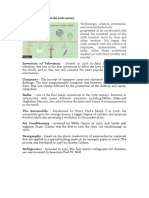Title: The Evolution of Gadgets: A Journey Through Technological Marvels
Introduction
In the ever-evolving landscape of technology, gadgets have become an integral part of our daily lives.
From the humble beginnings of simple mechanical devices to the sophisticated, interconnected
marvels of the digital age, gadgets have transformed the way we live, work, and communicate. This
article explores the fascinating journey of gadgets, tracing their evolution from the early inventions to
the cutting-edge innovations of today.
I. The Dawn of Gadgets
A. Early Mechanical Gadgets
The history of gadgets dates back centuries, with early examples rooted in simple mechanical devices.
From the astrolabe used for navigation to the mechanical clock, these inventions laid the foundation
for the gadgets we know today. The evolution of mechanical gadgets reflected the growing
understanding of physics, engineering, and craftsmanship during different historical periods.
B. Industrial Revolution and Mass Production
The 18th and 19th centuries witnessed the Industrial Revolution, a pivotal era that transformed
manufacturing processes. Mass production techniques allowed for the creation of affordable gadgets
for a broader audience. The telegraph, sewing machine, and the steam engine were among the
groundbreaking inventions that shaped the technological landscape and paved the way for the
modern era of gadgets.
II. The Electrification Era
A. Rise of Electricity
The late 19th and early 20th centuries marked the electrification era, leading to a wave of innovations
in gadgetry. The invention of the electric light bulb by Thomas Edison, followed by Nikola Tesla's
contributions to alternating current (AC), revolutionized the way gadgets were powered. Electricity
opened new possibilities for creating more versatile and efficient devices.
B. Radio and Communication Gadgets
The invention of the radio in the early 20th century was a milestone in the development of
communication gadgets. Radios became a household item, connecting people across vast distances
and transforming the way information was disseminated. This era also saw the emergence of early
telephones and televisions, laying the groundwork for future advancements in communication
technology.
III. The Digital Revolution
A. Emergence of Computers
The mid-20th century witnessed the birth of the digital revolution, marked by the development of
computers. Early computers were massive and complex machines, but they paved the way for the
miniaturization of technology. The invention of the microprocessor in the 1970s by Intel marked a
turning point, enabling the creation of smaller and more powerful gadgets.
B. Personal Computers and Consumer Electronics
The 1980s and 1990s saw the rise of personal computers, making computing power accessible to
individuals and businesses. Concurrently, consumer electronics began to flood the market, with
�gadgets like VCRs, camcorders, and early gaming consoles gaining popularity. The convergence of
computing and entertainment technologies laid the groundwork for the interconnected world of
gadgets we experience today.
IV. The Age of Smart Gadgets
A. Mobile Phones and Smartphones
The turn of the 21st century brought about a paradigm shift with the widespread adoption of mobile
phones. The transition from basic feature phones to smartphones revolutionized communication and
introduced a new era of interconnected devices. Smartphones became multifunctional gadgets,
combining the capabilities of phones, cameras, and computers in a single pocket-sized device.
B. Wearable Technology
The rise of wearable technology marked another significant trend in the gadget landscape. From
fitness trackers to smartwatches, wearables have become extensions of ourselves, providing real-time
data and enhancing our daily lives. These gadgets not only monitor health but also seamlessly
integrate with other devices, contributing to the concept of the Internet of Things (IoT).
V. Cutting-Edge Innovations
A. Artificial Intelligence and Virtual Assistants
The integration of artificial intelligence (AI) into gadgets has opened new frontiers of functionality.
Virtual assistants like Siri, Alexa, and Google Assistant have become commonplace, allowing users to
interact with gadgets using natural language. AI-driven features enhance user experience, from voice
recognition to predictive analytics, making gadgets more intuitive and responsive.
B. Augmented and Virtual Reality
Augmented reality (AR) and virtual reality (VR) have emerged as transformative technologies,
impacting various industries and creating immersive experiences. Gadgets like AR glasses and VR
headsets provide users with new ways to interact with the digital world, whether for gaming,
education, or professional applications. These innovations redefine the boundaries of what gadgets
can achieve.
VI. Sustainability and Future Trends
A. Eco-Friendly Gadgets
As technology advances, there is a growing awareness of the environmental impact of electronic
waste. Manufacturers are now prioritizing sustainability, developing gadgets with eco-friendly
materials, and implementing recycling programs. From solar-powered devices to energy-efficient
designs, the industry is striving to minimize its ecological footprint.
B. Future Trends in Gadgets
Looking ahead, the future of gadgets holds exciting possibilities. Advancements in materials science,
quantum computing, and biotechnology may lead to gadgets with unprecedented capabilities.
Concepts like brain-computer interfaces and bioelectronic devices hint at a future where gadgets
seamlessly integrate with the human body and mind.
Conclusion
The journey of gadgets is a testament to human ingenuity and our relentless pursuit of innovation.
From the early mechanical contraptions to the smart, interconnected devices of today, gadgets have
�shaped the way we live and interact with the world. As technology continues to evolve, the
possibilities for future gadgets are limitless, promising a world where the line between science fiction
and reality continues to blur. Gadgets are not just tools; they are a reflection of our progress,
creativity, and our collective ability to shape the future.








































































































